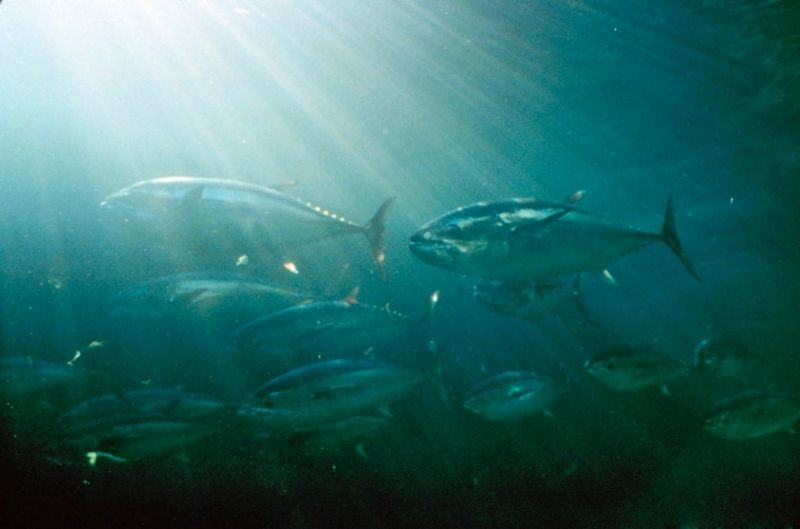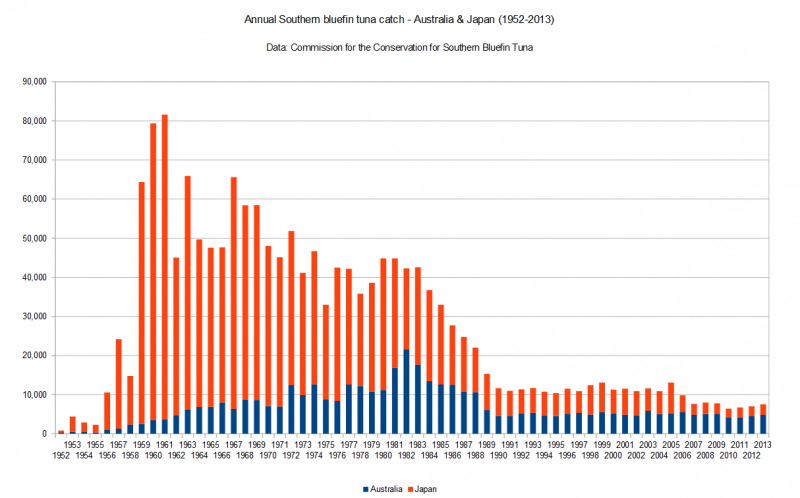Monday, July 24, 2017
Zhou Jinfeng
Secretary General, CBCGDF
Huang Shuya
Researcher, CBCGDF
Linda Wong
Deputy Secretary General, CBCGDF
Xiao Recio-Blanco
Director, Ocean Program
Bluefin tuna, the general group name of several species that belong to subgenus of true tunas Thunnus (Thunnus), are the largest of all tunas and have a natural lifespan of over 50 years. Reaching over two meters in length and weighing 200 kilograms as adults, the species is at the top of the marine food chain. But for great white sharks, bluefin tunas have few natural enemies. Sadly, in the last few decades, a new enemy has appeared: humans.
 |
The current situation is exacerbated by an inadequate, fragmented international legal framework. Under the United Nations Fish Stocks Agreement, Regional Fisheries Management Organizations (RFMOs) govern the fishing of tunas and other straddling, highly migratory fish stocks. Several RFMOs have been created to facilitate the management of tuna stocks that straddle between the coastal waters of nations and the high seas. However, country participation in RFMOs is voluntary, as are (in many cases) RMFO management rules, including complying with estimates of maximum sustainable yield and annual quotas.The three most recognized species are southern bluefin tuna (T. maccoyii), Atlantic bluefin tuna (T. thynnus), and Pacific bluefin tuna (T. orientalis). Since World War II, the bluefin tuna population has decreased by 80-90%, as several countries have been immoderately catching bluefin tuna, particularly the southern bluefin tuna, as their primary marine fishing resource. Today, the IUCN Red List designates the southern bluefin tuna (SBT) as Critically Endangered, the Atlantic bluefin tuna as Endangered, and the Pacific bluefin tuna as Vulnerable. Despite these species being on the verge of extinction, fishing continues. Worse yet, 90% of the individuals caught are juvenile and immature, thereby preventing existing wild populations of bluefin tuna to recover by natural reproduction.
Using SBT aquaculture ranches may sound hopeful, yet they fail to save wild populations, as most SBT ranches do not focus on conservation and ecological sustainability. Instead, the ranches usually bait the juvenile SBTs from the wild and keep them. Then, the juvenile SBTs are fed wild-caught small fish, often 15-20 times the ranched SBT’s weight. Specifically, every 100 kg of ranched SBT equals the consumption of 1.5-2 tons of wild caught small fish. The Marine Stewardship Council (MSC) therefore advises against the consumption of SBT, whether it is wild caught or ranched.
|
Moreover, several RFMOs only manage one or a few commercially valuable species, making it challenging to ensure the holistic, sustainable management of all living resources in the areas they administer. Several RFMOs recognize the relevance of basing management decisions in best available science as well as the duty to use the precautionary approach when monitoring the environmental impact of extractive activities. RFMOs, however, have yet to develop a generalized practice for conducting environmental impact assessments of the tuna fishing activities they authorize.
Sadly, some seafood sellers and existing fishing markets take advantage of the rarity of SBT and label it as an expensive “World Gourmet” luxury food item for wealthy consumers. For example, a leading Chinese e-commerce company announced on June 9 that they would import SBT from Australia and sell them as a luxury item on their website. This announcement instantly alarmed a large number of environmental groups in China, with many conservationists opting to boycott the company’s decision on selling SBT. The Endangered Species Fund of the China Biodiversity Conservation and Green Development Foundation (CBCGDF), along with three other environmental civil society organizations, filed an open request asking the company to cease selling SBT. On June 12, the company officially announced it would not sell any SBT products from their official platform, but as of June 16, 2017, many other sellers on the company’s website continued to sell SBT products.
The United Nation’s Sustainable Development Goals provide that businesses should and must play critical roles in the process of promoting sustainable development. Many businesses already understand that a sustainable approach brings with it profitable opportunities. Environmental groups like CBCGDF also recognize that biodiversity conservation needs the support and effort from all stakeholders and that the private sector has an important role to play in this pursuit. The story of the bluefin tuna only underscores the need for the fishing industry to work with environmental groups, conserve biodiversity, and promote the sustainable development of natural resources—for the benefit of all.
For the original article, please click: https://www.eli.org/vibrant-environment-blog/bluefin-tuna-critically-endangered-species-or-%E2%80%9Cworld-gourmet%E2%80%9D





